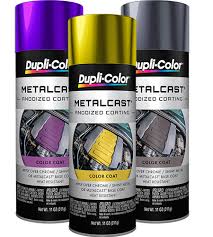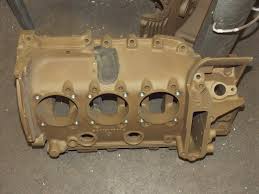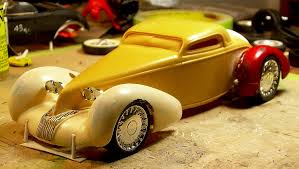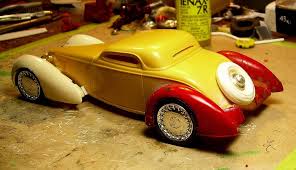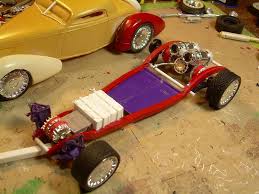-
Posts
38,189 -
Joined
-
Last visited
Content Type
Profiles
Forums
Events
Gallery
Everything posted by Ace-Garageguy
-

How to Remove "Ghost Trim"
Ace-Garageguy replied to diymirage's topic in Model Building Questions and Answers
As with most things in life, the "best" and the "easiest" tend to be mutually exclusive. Repeatedly priming and sanding is the only really effective way to do it with rattlecans, and eventually, the ghosting will stay down. It is, however, necessary to take precautions to prevent excessive film build in surrounding areas. Backtaping is strongly recommended. As usual, I speak from experience. This Olds hood was ghosting badly where the ornament had been removed. Multiple primer / sand / primer cycles cured it 100%, enough to be shot with hot Duplicolor color over soft late-model Revell plastic. If you have access to spray equipment, another sure-fire way is to shoot your work with a two-part catalyzed primer. It WILL kill any tendency for work to bleed through...but because of its extremely high-build characteristic, care must also be taken to avoid getting it on way too thick. This is a Nason urethane primer shot over extensive bodywork. Years later, zero ghosting. -

Ferrari's new single seater
Ace-Garageguy replied to 935k3's topic in General Automotive Talk (Trucks and Cars)
Man...that is one beautiful thing. -

Ferrari's new single seater
Ace-Garageguy replied to 935k3's topic in General Automotive Talk (Trucks and Cars)
Designing a "new" looking vehicle is getting more and more difficult when you think about it...which is why so many designs are encrusted with folds, creases and too-busy details stuck on just to set them apart from the competition. The shape of a bird has evolved to fit its function, and trying to design a "new" looking bird would be counterproductive. Likewise, aerodynamic constraints have defined the overall shapes of most vehicles, and the job pickup trucks do defines their shape as well...so again, sticking on superfluous design elements is the easiest way to set them apart from one another. I hope we'll see a return to relatively simple, clean designs like this Ferrari. Some of the stuff currently in production is just plain ugly, and it's not necessary to be ugly to be different...for a good designer, anyway...but there is a limit to how "different" a vehicle can be at this point in time, and still fulfill its necessary functions. -

Ferrari's new single seater
Ace-Garageguy replied to 935k3's topic in General Automotive Talk (Trucks and Cars)
Holy moley. A clean, flowing design without tons of folds and creases going every-which-way and randomly stuck-on bits. I like it. A lot. It looks modern. It looks fast. But it doesn't look overworked, like it spent too long being tinkered with in committee. Hopefully it starts a trend back to simple elegance. -

Model Train Show - offending the purists
Ace-Garageguy replied to iamsuperdan's topic in The Off-Topic Lounge
It's the same as the guys who take the time to get all the technical details right on their car builds looking down their noses at the slammer guys who lop off the tops of huge tires to get stances that are absolutely impossible in reality. Some of the slammers I've seen are absolutely stunning, and are often the models uninitiated bystanders go for because they look so cool...even though they could never work as depicted. There's no "right" way to enjoy these hobbies, but it's important to remember not everyone HAS to like everything. We should be big enough to let other people have their own fun, but we also don't necessarily have to embrace it. -

Model Train Show - offending the purists
Ace-Garageguy replied to iamsuperdan's topic in The Off-Topic Lounge
Dave, I'm not being argumentative, just looking for clarification and correcting what I may have misunderstood. My impression has always been that O "fine scale" (2-rail) was the more realistic end of the O-scale spectrum, and that "high-rail" and "tinplate" were the more toy-like end. BUT...I admittedly know much more about HO now than O, though I got my start as a youngster in Lionel O-scale tinplate. Granted, $1500 seems like a lot of jack for a toy. PS. That sure is a pretty Pennsy S1. I haven't found one in HO that I can comfortably afford yet... -

Chrysler factory AFX cars (12 of them), paint
Ace-Garageguy replied to fiatboy's topic in WIP: Drag Racing Models
Anybody wanting to do very realistic looking "anodized" parts should have a look at these... https://duplicolor.com/product/metalcast-anodized-automotive-paint -

Model Train Show - offending the purists
Ace-Garageguy replied to iamsuperdan's topic in The Off-Topic Lounge
I did some digging and found a shot of his "Organic Switcher #13" (a Stegosaurus named Emma) at the 1:09 mark in the video below. But these big jokes weren't part of the usual operational layout, and his devotion to getting the tech and scale and build details right, even when he built the model of a completely non-existent 2-10-0 "freelanced" locomotive (the subject of the video) is apparent. -

Porsche 907 engine color question
Ace-Garageguy replied to magicmustang's topic in Model Building Questions and Answers
What you're seeing there as the "block" is in reality the engine cooling "tin", made from sheet aluminum, or fiberglass. The cooling "tin" on your particular example appears to be the fiberglass version, which is the natural translucent gray-yellow color of the material. As 70mach1 notes, it may have a coating of yellow-green-gray zinc-chromate, and is also similar to the color of the old Dow 7 coating. This is a magnesium Porsche engine case done with Dow 7. There's a thread on here somewhere about matching the color. And this: https://www.jalopyjournal.com/forum/threads/what-color-paint-to-use-to-match-dow-7-coating.235753/ When these engines get restored, repairs to the fiberglass cooling shrouds are often needed, and short of making new parts, there's no way of doing an invisible repair worthy of a megabuck historic car...so the shrouds are sometimes painted with a color that approximates the original fiberglass. The fan itself can be either cast aluminum or molded reinforced plastic, which is a translucent yellowish whitish, kinda like the shrouds, but slightly different. The injector tubes could also be molded glass-reinforced plastic, same color as the engine cooling fan (though a slightly different hue in your photo), or fabricated aluminum The fan duct was fiberglass, and is also the natural translucent yellow/gray color of f'glass moldings. Porsche had a thing for plastic fuel lines in those days, and they were a milky white, also slightly translucent. Here's another engine. In this case, the intake trumpets are the same color as the fan, indicating they were made by the same process at the time, in closed, matched molds. The airbox lowers and fan shroud are a slightly different color here, and look to be open-mold, hand layups (due to the slight irregularity of the color, and the relatively simple shapes). EDIT: The earliest versions of these engines used sheet aluminum engine cooling "tin". When you look closely at the fiberglass version of the same parts, it's very obvious that the molds were made from sheetmetal masters. I do not honestly know if any were raced with the aluminum cooling jacket, but most definitely, prototype, test, and development engines would have been so equipped. -

Model Train Show - offending the purists
Ace-Garageguy replied to iamsuperdan's topic in The Off-Topic Lounge
Here's one of the few surviving films of John Allen's extraordinary work on the G&D. Building through the late 1940s through the '50s and '60s, his outstanding degree of train control was accomplished without DCC, and his craftsmanship stands in silent testimony to what can be accomplished without the multitude of kits, specialty tools, and materials available today. -

Model Train Show - offending the purists
Ace-Garageguy replied to iamsuperdan's topic in The Off-Topic Lounge
But John Allen was one of the most highly accomplished fine-scale modelers of his time (and was one of my heroes when I was a young RR modeler...still is, actually). Allen was a funny guy, and much of his writing reflects his sense of humor. As you say, the Gorre and Dephetid RR included lots of little jokes, but blatant mixing scales and including things like dinosaurs (except for the stegosaurus "organic switcher" ) and spacecraft, and other anachronisms that would mar the era-correct atmosphere his work was noted for, weren't part of the program (I have a couple of pieces of G&D rolling stock, as a reminder of just how inspirational his work truly was). He WAS a "freelance" builder, which means that he wasn't a slave to exact copies of real equipment and railroads, as some guys are, but still had knowledge of and respect for how things were made and worked in reality...another one of the characteristics that made his work so entertaining as well as realistic. -
It was necessary to pin this windshield frame to the cowl, as it is to be removable when the model is completed, so it can be displayed with a tonneau for dry-lakes racing. The headlight stanchions are also to be pinned for the same reason. BEFORE PRIMER OR PAINT, I lightly glued the windshield base to the cowl EXACTLY WHERE I WANTED IT, at the correct angle. Next, I marked carefully around the base of the pillars with a very sharp implement. I then removed the windshield and drilled .030" holes (to use steel straight-pin stock) straight DOWN, in the CENTER OF THE MARKED LOCATIONS. The windshield was again lightly glued to the cowl, aligning it precisely with the marks. Using the previously drilled holes in the cowl to guide the drill bit, holes in the bases of the windshield pillars were drilled UP from the underside of the cowl, and the windshield was again carefully snapped off of the car. The resulting holes match exactly, and are all at the correct angles relative to each other. Pins were installed in the windshield pillar bases with CA, trimmed for length, and the windshield always goes back in the EXACT same location. At this point, priming and paint were completed. The holes drilled in the cowl are visible in this primer shot. Here's the full build thread, if anyone is interested. NOTE: Though the above method works for many parts (like mirrors, etc.), sometimes eyeball-engineering is the only solution. The roll-bar hoop on this model needs to be removable to display the car's guts with the body off. Carefully centering the drill bit in the ends of the parts to be pinned together is the only solution, and I didn't get it quite right. When that happens, just fill the drilled holes with some styrene dissolved in liquid cement, let it dry THOROUGHLY, and try again.
-

Model Train Show - offending the purists
Ace-Garageguy replied to iamsuperdan's topic in The Off-Topic Lounge
Agreed entirely, 100%. But there are occasionally those who imply, whether intentional or not, that striving for perfection (impossible to achieve, but definitely worth pursuing) and a very high level of accuracy somehow isn't "fun". I can assure everyone that working to a high and serious standard IS in fact enjoyable for those who go that way, including the setbacks, do-overs and occasional disappointments that accompany that approach. -

Flintstone '34 Ford Bonneville coupe
Ace-Garageguy replied to misterNNL's topic in Model Building Questions and Answers
-
Plastic bread clips make great, free, and disposable putty tools. They are styrene, have the right amount of springiness to do the job well, and again, they're free. No need to clean 'em. The longer ones work the best, but they'll all do the job nicely. I'll often use the spreaders Joe shows for mixing, and the clips for spreading the goo. Strips of styrene sheet can be used the same way, but I like repurposing something that's normally thrown out anyway. Another material that makes great filler spreaders is expired credit-card stock. They cut easily with scissors or a knife, and also have the right amount of stiffness.
-

Model Train Show - offending the purists
Ace-Garageguy replied to iamsuperdan's topic in The Off-Topic Lounge
And some lose sight of the fact that it's "fun" for some modelers to build rivet-counted accuracy. When the fun-police begin trying to force us all to enjoy everything equally, no matter how useless and stupid we, as individuals, may see some things, we're done. -

Model Train Show - offending the purists
Ace-Garageguy replied to iamsuperdan's topic in The Off-Topic Lounge
Fantastic. -

Model Train Show - offending the purists
Ace-Garageguy replied to iamsuperdan's topic in The Off-Topic Lounge
Well, there are probably more approaches to model railroading than most other model forms. The first photo depicts a 3-rail layout. 3-rail has more of a "toy" emphasis these days (although in the past, some very highly detailed and sophisticated 3-rail layouts were built), and lack of detail and poor scale fidelity, even mixing scale scene elements (like some kids who aren't aware of "scale" yet will do) is common. I'm personally a hard-core "scale model" railroader (as I am with cars), and I just have no interest in the "toy" layout style. But I'll never waste any energy bashing somebody who DOES like it. If they're having fun enjoying that end of the hobby, fine. I don't see the point in criticizing people's interests, but I don't have to share them, or pay any attention to them either. My own interest runs towards scale model railroad scenes that do a good job of representing reality realistically, like this (and there are plenty of flaws and shortcomings in this shot as well). No Batmobiles or StarWars walkers need apply. -

Vanwall, love to see a kit of this
Ace-Garageguy replied to Greg Myers's topic in General Automotive Talk (Trucks and Cars)
Old Merit (English) kit, 1/24 scale. Though the kit has no engine or opening panels, you could do a credible powerplant by first lopping off a couple of cylinders from an E-type Jag mill, and flattening the cam covers behind the sprocket bumps. The carbs are individual Amals, not too hard to scratch, with aluminum stacks from the aftermarket. (NOTE: The later engine shown has Bosch timed mechanical fuel injection, but retains the Amal carbs as throttle-bodies...much like some EFI systems made today.) -

How aluminum airplanes are built...
Ace-Garageguy replied to Ace-Garageguy's topic in The Off-Topic Lounge
Yes, these engines are in the 700 pound range, which is about as much as an old Jag inline six. There's not much in the way of heavy parts considering the power they produce. On the other hand, something like an old Merlin V-12 weighs around 1500 pounds, and the part of the structure that carries it and feeds the loads into the structure usually has to be heavier too. For further comparison, the big radial engines on something like a B-17 weighed around 800 pounds each. There are also different ways to accomplish some things that differ from what's shown here. For instance, some aircraft have used wing spar sections or other structural parts machined from billet, and the F-22, among others, uses fuselage bulkheads machined from billet. Extrusions can also be used, and some aircraft employ metal honeycomb sections as well. Some commercial airliners use wing-skins that are chemically machined...but in general terms, all aluminum aircraft use similar construction to what's shown here, and if you were to walk through any aluminum aircraft factory, it would look much like what you see in the video. -

Malco gasser fuel/cooling detail
Ace-Garageguy replied to Farmboy's topic in WIP: Drag Racing Models
Thank you, Nick. -

Malco gasser fuel/cooling detail
Ace-Garageguy replied to Farmboy's topic in WIP: Drag Racing Models
Great pix, one and all. I have this kit, but hadn't begun the research yet. Thanks loads. -
I would make a typically critical-of-modern-society comment, but having just recently been reinstated, I'll shut up and smile.
-

Lindbergs 1/12 FIAT dragster
Ace-Garageguy replied to MPi-KM's topic in General Automotive Talk (Trucks and Cars)
I have one in stock, but just put it on a high shelf. If I remember correctly, it's a mixed up mashup generic thing kinda like an SBC or a Ford Y-block, but not. Nothing in this kit is a particularly accurate rendition of anything in reality. Anybody who knows otherwise, please feel free to correct me. -
This is a well produced video documentary on aluminum aircraft construction. Though it's specifically about the Lear, every aluminum airplane, including all the fighters and bombers from WW II, and post-war Cessnas and Pipers, has been built pretty much the same way. This may be of interest to car-guys, because, though the aerodynamic principles affecting airplanes and cars are identical, the build methods are very different.

